Study on Numerical Simulation of Gas–Water Two-Phase Micro-Seepage Considering Fluid–Solid Coupling in the Cleats of Coal Rocks
Abstract
:1. Introduction
2. Governing Equations
2.1. Assumptions
- (1)
- Both the gas and water phases are incompressible fluids (Cphi = 0), and there is no material exchange between them [25].
- (2)
- (3)
- The two-dimensional model has no height difference in the vertical direction. Fluid flow in the cleat follows the Navier–Stokes equation, ignoring the influence of gravity [26].
- (4)
- The fluid is continuous and has no voids inside, such as no dissolved bubbles, aggregation without foggy particles, etc.
- (5)
- COMSOL Multiphysics software simulates real physical phenomena by solving partial differential equations. Therefore, all fields involved in the model are differentiable, such as pressure field, saturation field, stress field, etc. [11].
2.2. Fluid Flow
2.3. Phase Field Method
2.4. Solid Mechanics
3. Numerical Model of Microscopic Two-Phase Flow in Coal and Rock
3.1. Geometric Model
3.2. Boundary Conditions
3.3. Validation of Simulation Method
4. Results and Discussion
4.1. Analysis of Two-Phase Flow Interface
4.2. Contrast of Two-Phase Saturation
4.3. Analysis of Sensitivity
4.3.1. Injection Pressure
4.3.2. Wettability
5. Conclusions
- (1)
- The displacement process can be divided into two stages: the gas phase front reaches the outlet along the preponderance seepage path, and the gas phase continues to drive residual water on the coal cleat wall until the flow reaches a stable state. The displacement process has an obvious viscous fingering phenomenon and residual water characteristics.
- (2)
- Increasing injection pressure is beneficial for the gas phase to break through narrow areas; however, residual water at dead corners of coal cleats is difficult to displace. The final gas saturation depends on the pore structure of the coal rock. The injection pressure was increased from 60 kPa to 120 kPa, the displacement completion time was reduced from 1.3 × 10−4 s to 7 × 10−5 s, and the final gas saturation was 98%.
- (3)
- The larger the contact angle, the faster the two-phase interface advance speed, and the lower the residual water distribution range. The gas-wet state contributes to enhanced oil recovery. The contact angle increased from 45° to 120°, resulting in a significant enhancement of the final gas phase saturation from 0.871 to 0.992, representing an increase of 12.2%.
Author Contributions
Funding
Data Availability Statement
Conflicts of Interest
References
- Han, F.; Busch, A.; van Wageningen, N.; Yang, J.; Liu, Z.; Krooss, B.M. Experimental study of gas and water transport processes in the inter-cleat (matrix) system of coal: Anthracite from Qinshui Basin, China. Int. J. Coal Geol. 2010, 81, 128–138. [Google Scholar] [CrossRef]
- Gao, C.; Liu, D.; Li, Z.; Cai, Y.; Fang, Y. Fluid performance in coal reservoirs: A comprehensive review. Geofluids 2021, 2021, 6611075. [Google Scholar] [CrossRef]
- Du, Z.; Tao, Y.; Zhang, X.; Ding, W.; Huang, Q. CBM exploration: Permeability of coal owing to cleat and connected fracture. Energy Explor. Exploit. 2022, 40, 38–56. [Google Scholar] [CrossRef]
- Gilman, A.; Beckie, R. Flow of coal-bed methane to a gallery. Transp. Porous Media 2000, 41, 1–16. [Google Scholar] [CrossRef]
- Zhu, Q.; Yang, Y.; Zuo, Y.; Song, Y.; Guo, W.; Tang, F.; Ren, J.; Wang, G. On the scientific exploitation of high-rank CBM resources. Nat. Gas Ind. B 2020, 7, 403–409. [Google Scholar] [CrossRef]
- Chen, Y.; Xu, J.; Chu, T.; Peng, S.; Zhang, C.; Wang, M. The evolution of parameters during CBM drainage in different regions. Transp. Porous Media 2017, 120, 83–100. [Google Scholar] [CrossRef]
- Geng, J.; Zeng, G.; Liu, C.; Li, X.; Zhang, D. Development and application of triaxial seepage test system for gas-water two-phase in coal rock. Energy 2023, 277, 127439. [Google Scholar] [CrossRef]
- Wang, Q.; Su, X.; Feng, Y.; Wang, H.; Song, J. Experimental study of gas-water two-phase flow patterns in fracture: Implication for enhancing coalbed methane production. J. Pet. Sci. Eng. 2021, 207, 109168. [Google Scholar] [CrossRef]
- Su, X.; Liu, Y.; Cui, Z.; Zhang, J.; Yu, L.; Wang, K. Influence of depressurization rate on gas production capacity of high-rank coal in the south of Qinshui Basin, China. Pet. Explor. Dev. 2019, 46, 613–620. [Google Scholar] [CrossRef]
- Shao, P.; Wang, X.; Song, Y.; Li, Y. Study on the characteristics of matrix compressibility and its influence factors for different rank coals. J. Nat. Gas Sci. Eng. 2018, 56, 93–106. [Google Scholar] [CrossRef]
- Song, R. Research on the Mesoscopic Mechanism of Thermal Fluid Solid Coupling in Rock Based on Microscale Reconstruction Model. Ph.D. Thesis, Southwest Petroleum University, Chengdu, China, 2016. [Google Scholar]
- Li, S.; Fan, C.; Han, J.; Luo, M.; Yang, Z.; Bi, H. A fully coupled thermal-hydraulic-mechanical model with two-phase flow for coalbed methane extraction. J. Nat. Gas Sci. Eng. 2016, 33, 324–336. [Google Scholar] [CrossRef]
- Sun, Z.; Shi, J.; Wu, K.; Miao, Y.; Zhang, T.; Feng, D.; Xiao, Z.; Wu, N.; Lin, W.; Li, X. A fully-coupled gas-water two phase productivity equations for low-permeability CBM wells. J. Pet. Sci. Eng. 2018, 166, 611–620. [Google Scholar] [CrossRef]
- Yang, R.; Ma, T.; Xu, H.; Liu, W.; Hu, Y.; Sang, S. A model of fully coupled two-phase flow and coal deformation under dynamic diffusion for coalbed methane extraction. J. Nat. Gas Sci. Eng. 2019, 72, 103010. [Google Scholar] [CrossRef]
- Zeguai, S.; Chikh, S.; Tadrist, L. Experimental study of air-water two-phase flow pattern evolution in a mini tube: Influence of tube orientation with respect to gravity. Int. J. Multiph. Flow 2020, 132, 103413. [Google Scholar] [CrossRef]
- Mao, N.; Kang, C.; Ding, K.; Cao, Q. Gas-liquid two-phase flow patterns in the wake of a submerged nozzle under co-flow condition. Int. J. Multiph. Flow 2021, 138, 103604. [Google Scholar] [CrossRef]
- Bai, T.; Chen, Z.; Aminossadati, S.M.; Pan, Z.; Liu, J.; Li, L. Characterization of coal fines generation: A micro-scale investigation. J. Nat. Gas Sci. Eng. 2015, 27, 862–875. [Google Scholar] [CrossRef]
- Ma, T.; Rutqvist, J.; Oldenburg, C.M.; Liu, W.; Chen, J. Fully coupled two-phase flow and poromechanics modeling of coalbed methane recovery: Impact of geomechanics on production rate. J. Nat. Gas Sci. Eng. 2017, 45, 474–486. [Google Scholar] [CrossRef]
- Zhu, J.; Tang, J.; Hou, C.; Shao, T.; Zhao, Y.; Wang, J.; Lin, L.; Liu, J.; Jiang, Y. Two-Phase Flow Model of Coalbed Methane Extraction with Different Permeability Evolutions for Hydraulic Fractures and Coal Reservoirs. Energy Fuels 2021, 35, 9278–9293. [Google Scholar] [CrossRef]
- Dong, W.; Wang, J.; Wang, J. Two-phase flow in coalbed methane reservoirs with multiple-fractured horizontal well. J. Pet. Sci. Eng. 2022, 208, 109510. [Google Scholar] [CrossRef]
- Sun, Z.; Shi, J.; Wang, K.; Miao, Y.; Zhang, T.; Feng, D.; Sun, F.; Wang, S.; Han, S.; Li, X. The gas-water two phase flow behavior in low-permeability CBM reservoirs with multiple mechanisms coupling. J. Nat. Gas Sci. Eng. 2018, 52, 82–93. [Google Scholar] [CrossRef]
- Shu, Y.; Sang, S.; Zhou, X.; Zhao, F. A Coupled Hydraulic–Mechanical Model with Two-Phase Flow for Fracturing Development of Undersaturated Coalbed Methane Reservoirs Considering Permeability Velocity-Sensitive Damage. Nat. Resour. Res. 2023, 32, 2053–2076. [Google Scholar] [CrossRef]
- Xu, Y.; Chen, X.; Yu, J.Y. Experimental study of the radial multi-scale dynamic diffusion model for gas-bearing coal. Min. Miner. Depos. 2022, 16, 80–86. [Google Scholar] [CrossRef]
- Li, H.; Huang, B.; Zheng, W.; Zhao, X.; Tannant, D. Effect of proppant distribution in hydraulic fractures on coalbed methane extraction. Results Eng. 2023, 20, 101550. [Google Scholar] [CrossRef]
- Gawin, D.; Baggio, P.; Schrefler, B.A. Coupled heat, water and gas flow in deformable porous media. Int. J. Numer. Methods Fluids 1995, 20, 969–987. [Google Scholar] [CrossRef]
- Bertrand, F.; Buzzi, O.; Collin, F. Cleat-scale modelling of the coal permeability evolution due to sorption-induced strain. Int. J. Coal Geol. 2019, 216, 103320. [Google Scholar] [CrossRef]
- Bai, T.; Chen, Z.; Aminossadati, S.M.; Li, L.; Liu, J.; Lu, H. Dimensional analysis and prediction of coal fines generation under two-phase flow conditions. Fuel 2017, 194, 460–479. [Google Scholar] [CrossRef]
- Sun, Y.; Bao, C.; Jiang, Z.; Zhang, X.; Gao, T. A two-dimensional numerical study of liquid water breakthrough in gas diffusion layer based on phase field method. J. Power Sources 2020, 448, 227352. [Google Scholar] [CrossRef]

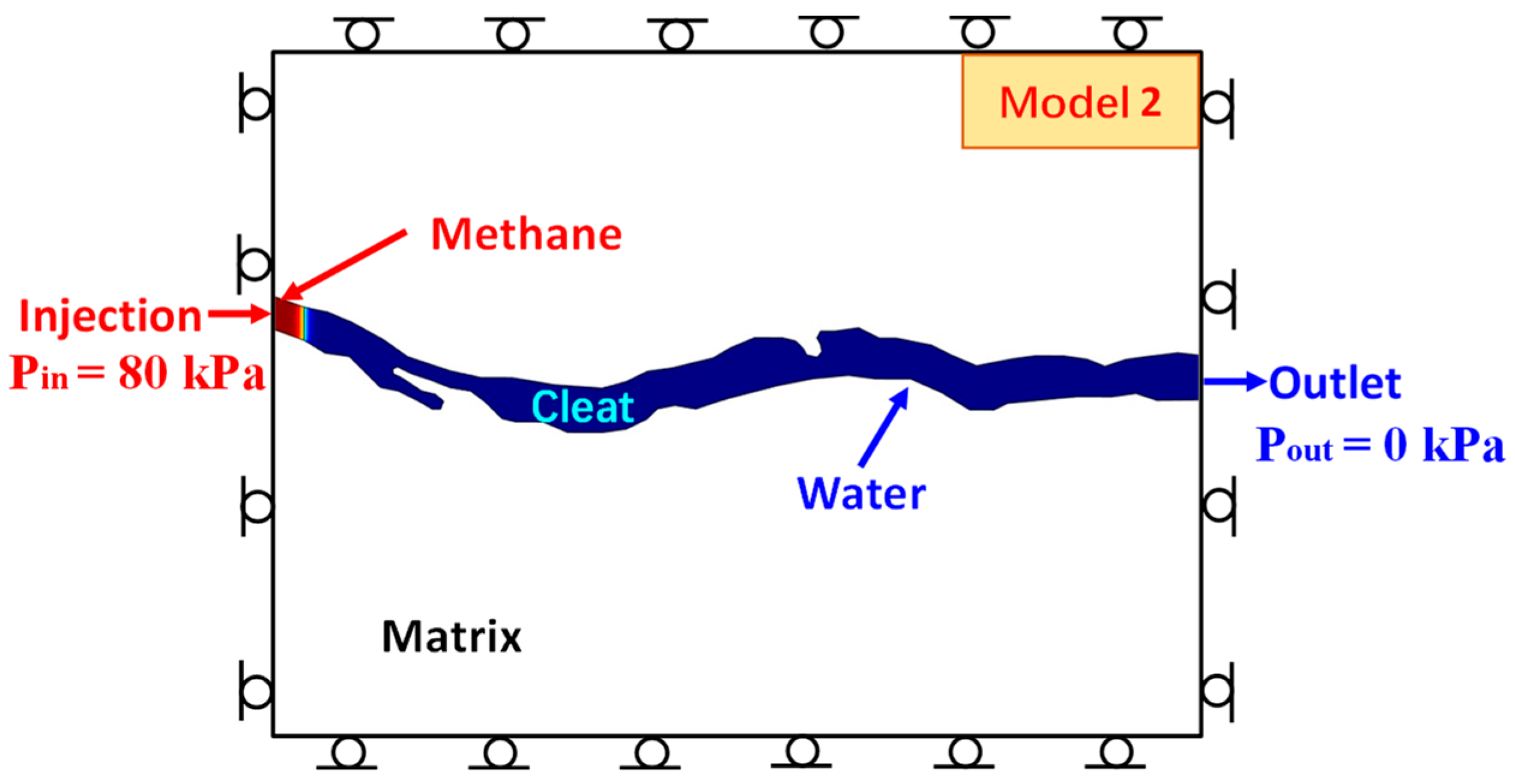
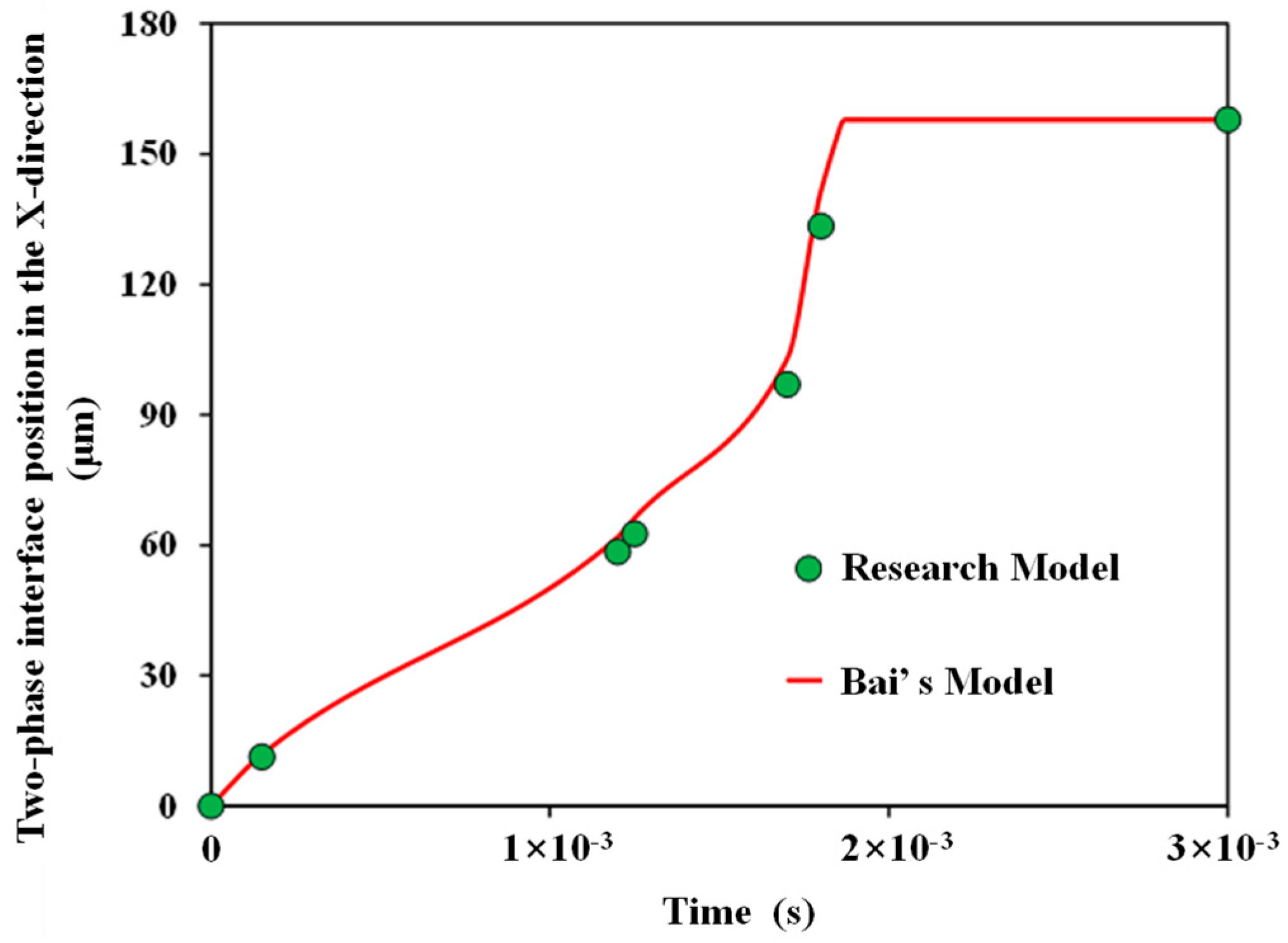
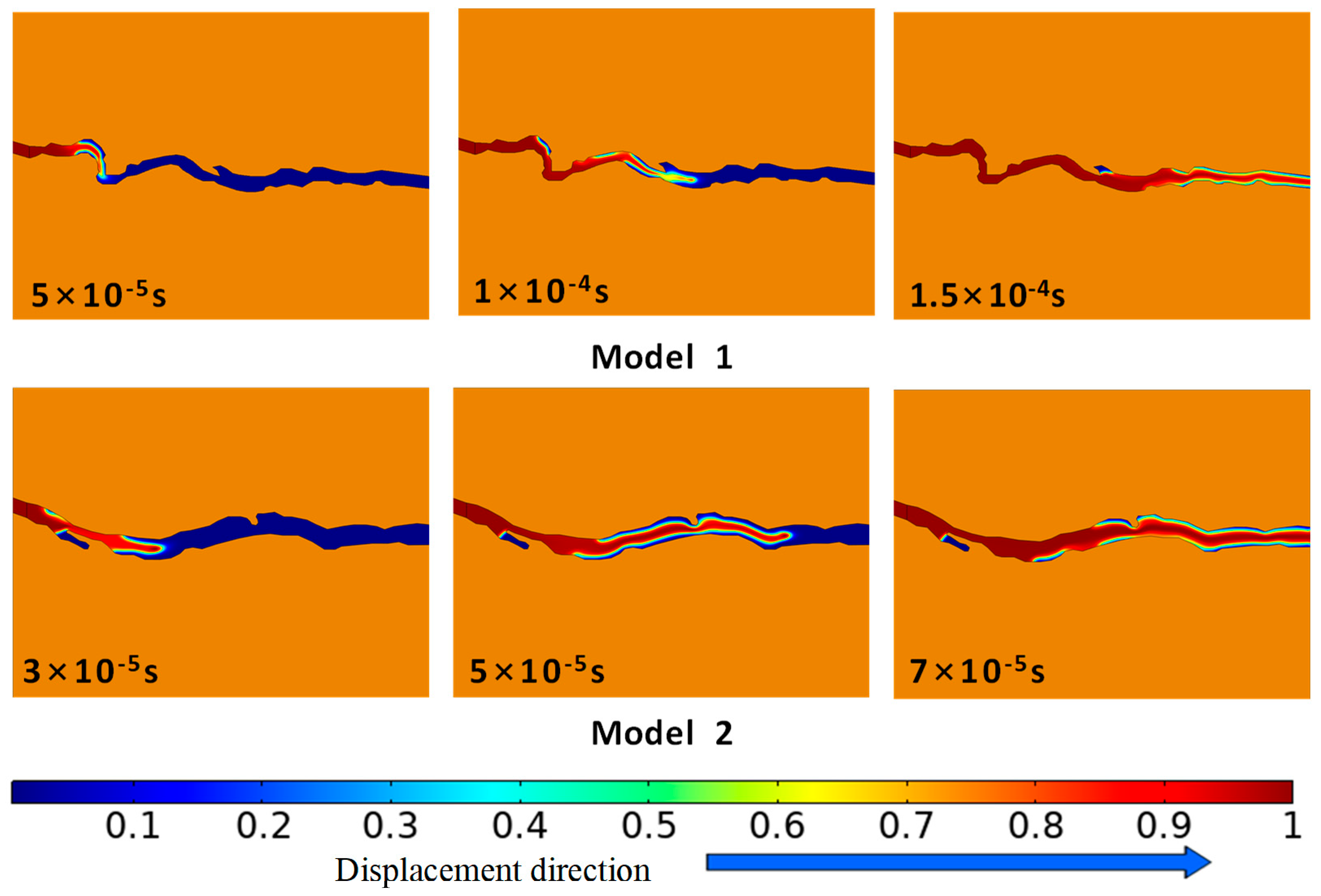
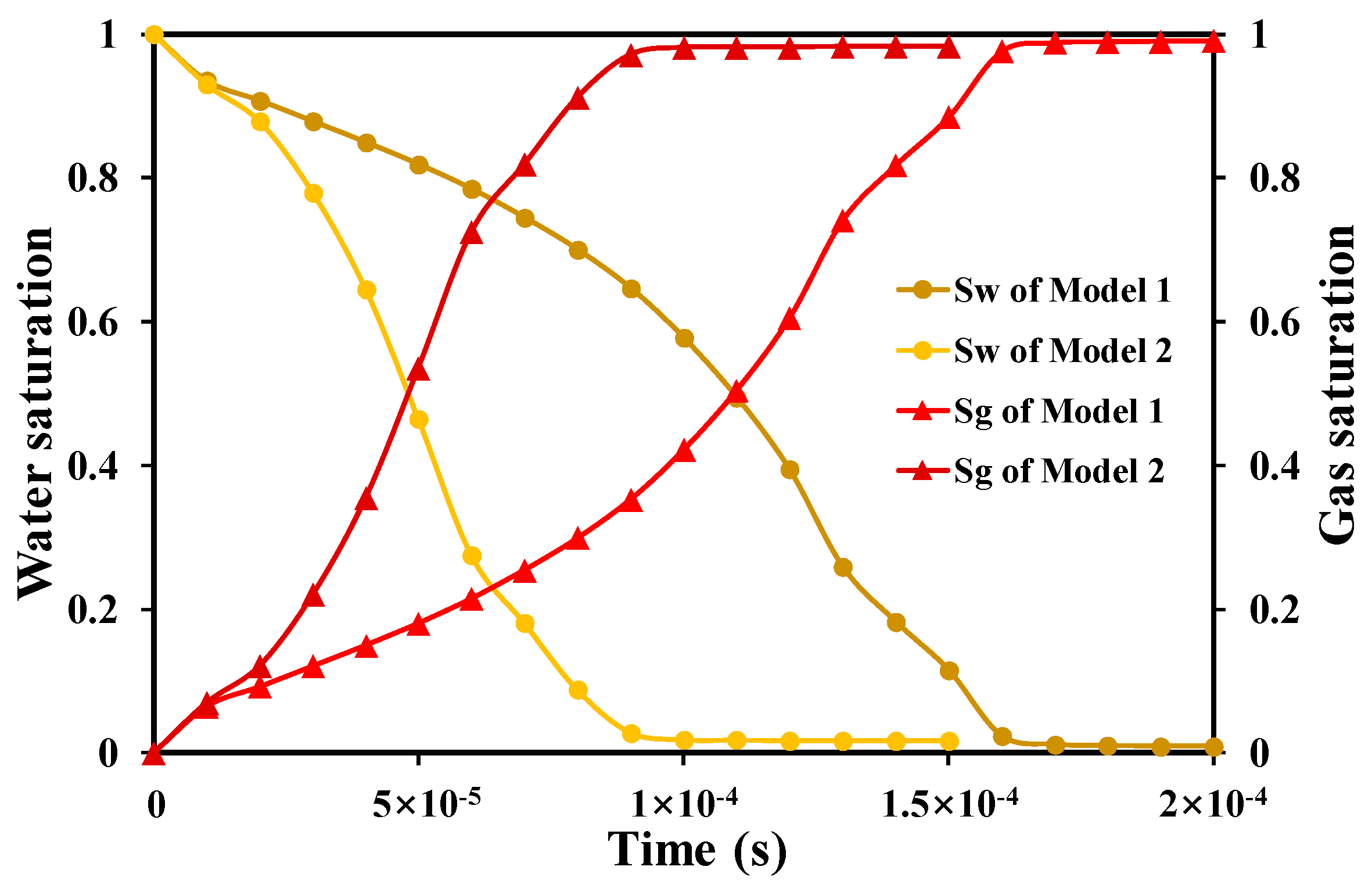



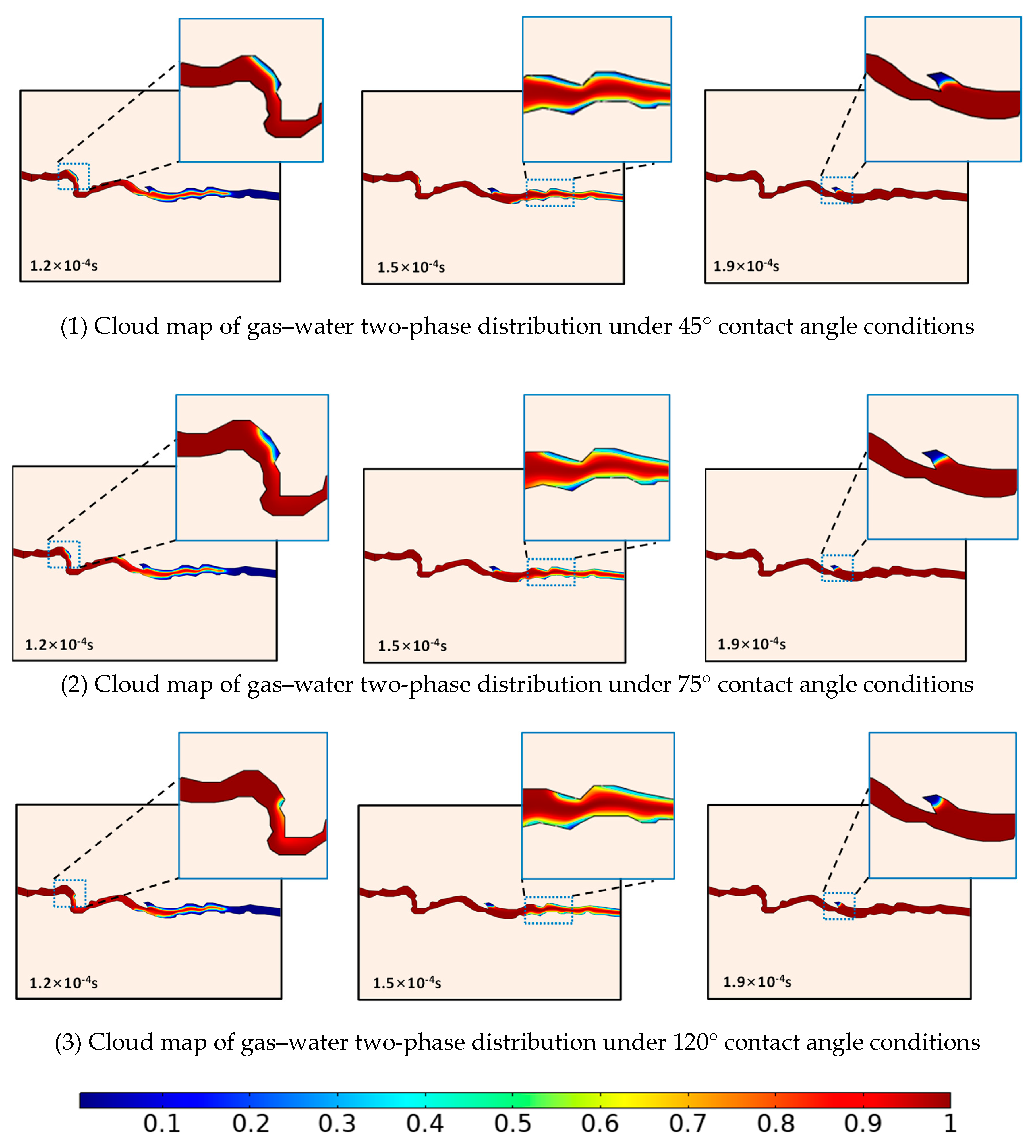
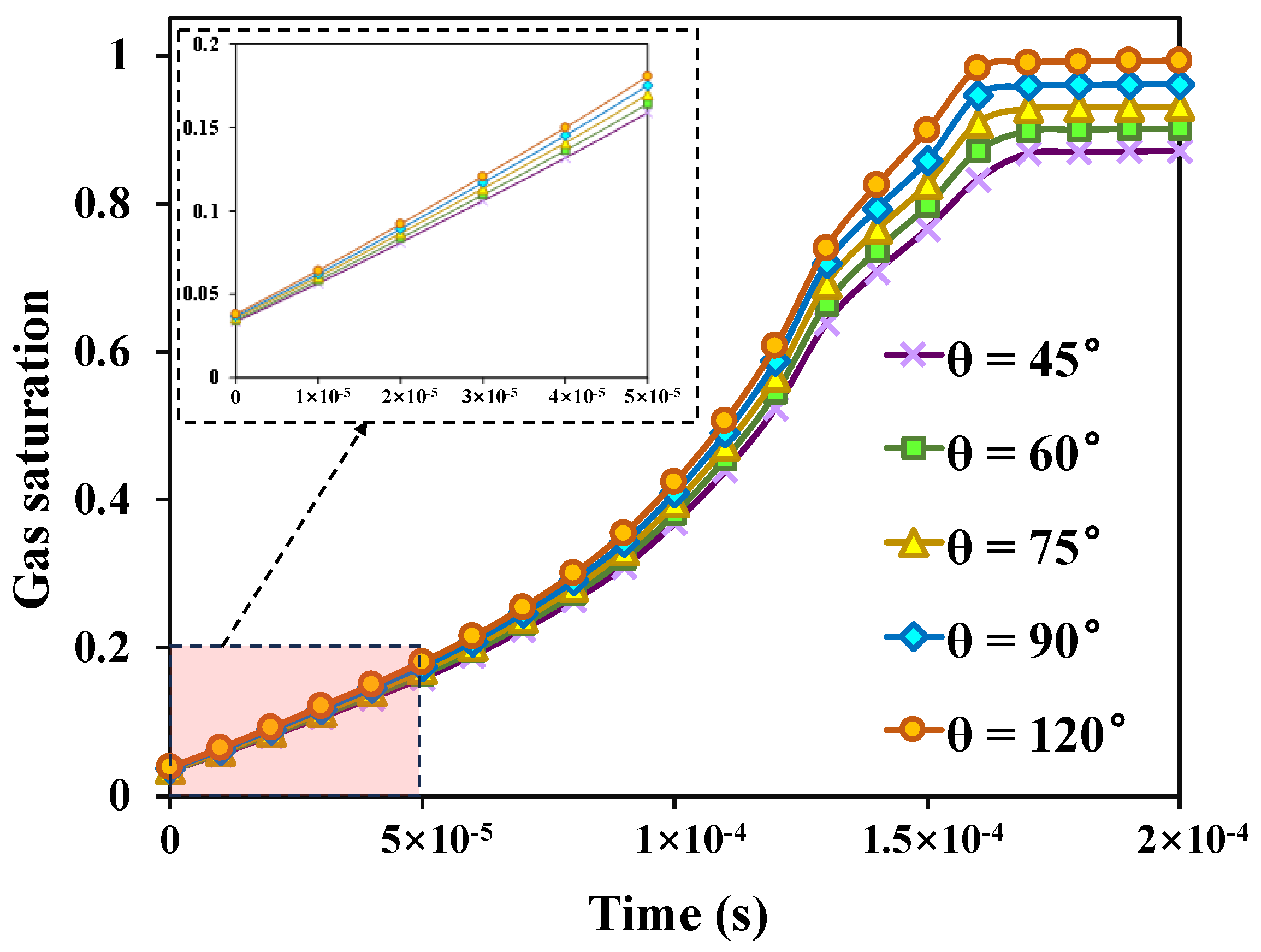
| Property | Value | Unit |
|---|---|---|
| Density of water phase | 1000 | kg/m3 |
| Viscosity of water phase | 0.001 | Pa·s |
| Density of gas phase | 0.66 | kg/m3 |
| Viscosity of gas phase | 7.4 × 10−6 | Pa·s |
| Contact angle | 60 | ° |
| Young’s modulus | 5.8 | GPa |
| Poisson’s ratio | 0.36 | / |
| Density of coal rocks | 1300 | kg/m3 |
| Injection pressure | 80 | kPa |
Disclaimer/Publisher’s Note: The statements, opinions and data contained in all publications are solely those of the individual author(s) and contributor(s) and not of MDPI and/or the editor(s). MDPI and/or the editor(s) disclaim responsibility for any injury to people or property resulting from any ideas, methods, instructions or products referred to in the content. |
© 2024 by the authors. Licensee MDPI, Basel, Switzerland. This article is an open access article distributed under the terms and conditions of the Creative Commons Attribution (CC BY) license (https://creativecommons.org/licenses/by/4.0/).
Share and Cite
Qian, C.; Xie, Y.; Zhang, X.; Zhou, R.; Mou, B. Study on Numerical Simulation of Gas–Water Two-Phase Micro-Seepage Considering Fluid–Solid Coupling in the Cleats of Coal Rocks. Energies 2024, 17, 928. https://doi.org/10.3390/en17040928
Qian C, Xie Y, Zhang X, Zhou R, Mou B. Study on Numerical Simulation of Gas–Water Two-Phase Micro-Seepage Considering Fluid–Solid Coupling in the Cleats of Coal Rocks. Energies. 2024; 17(4):928. https://doi.org/10.3390/en17040928
Chicago/Turabian StyleQian, Cheng, Yaxi Xie, Xiujun Zhang, Ruiqi Zhou, and Bixin Mou. 2024. "Study on Numerical Simulation of Gas–Water Two-Phase Micro-Seepage Considering Fluid–Solid Coupling in the Cleats of Coal Rocks" Energies 17, no. 4: 928. https://doi.org/10.3390/en17040928
APA StyleQian, C., Xie, Y., Zhang, X., Zhou, R., & Mou, B. (2024). Study on Numerical Simulation of Gas–Water Two-Phase Micro-Seepage Considering Fluid–Solid Coupling in the Cleats of Coal Rocks. Energies, 17(4), 928. https://doi.org/10.3390/en17040928





